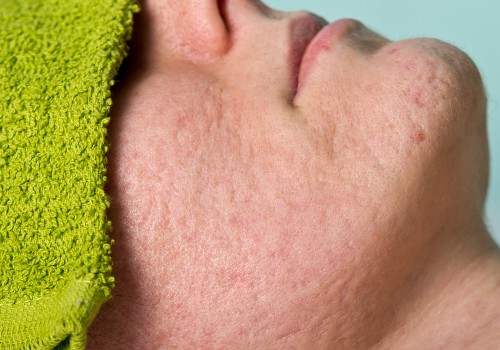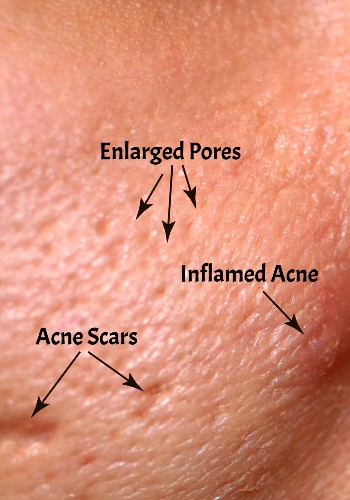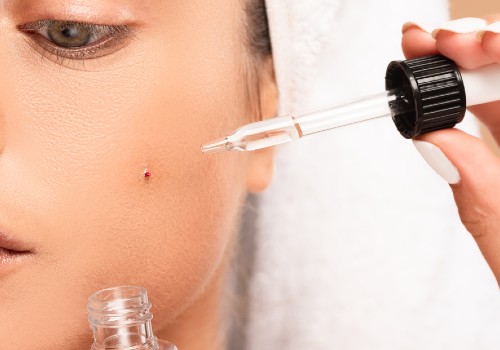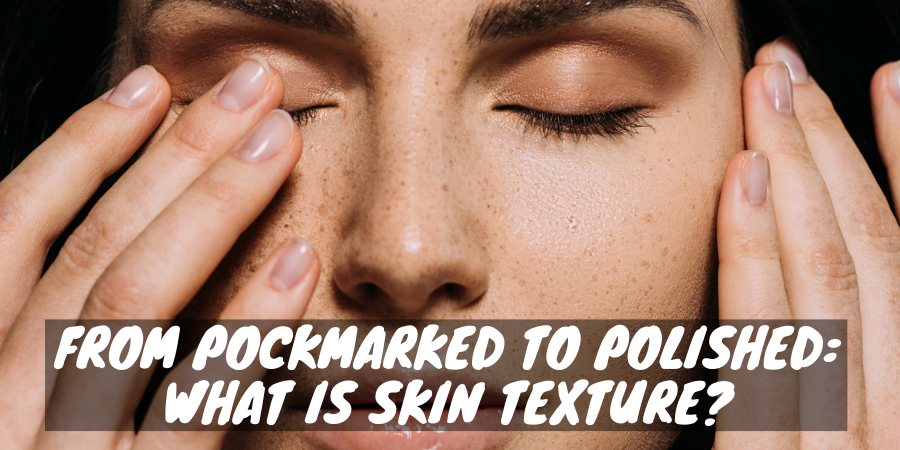You already know about skin tone and you’ve successfully identified your skin type.
But what about your skin texture?
If you’re not sure how to define your skin’s texture (or how to improve it), then read on — we’ve got the answers you’re looking for.
All About Skin Texture: Types and Causes

Healthy Skin Texture Vs. Uneven Skin Texture
The term “skin texture” refers to the condition of the surface of your skin.
It’s both visual and tactile in nature. Skin texture doesn’t just affect the way your skin looks — it also affects the way it feels to the touch.
Healthy skin’s texture is supple, smooth and soft. It’s neither greasy nor dry to the touch, appearing bright and radiant.
But if your skin texture is uneven, it’ll look dull and feel rough. It may have bumps, flaky patches, breakouts and enlarged pores, and if you run your finger along it, it’ll feel more like a cinder block than a smooth pebble.
Causes of Uneven Skin Texture

Sensitivity to Ingredients in Food, Skincare Products and Makeup
One of the most common causes of uneven skin texture is ingredient sensitivity.
You may not have a full-blown allergy to the offending ingredient, but it’s incompatible enough with your body to cause your skin to react poorly to its presence.
Gluten, sugar and soy are common food components that cause skin reactions. Often, the reaction consists of red bumps and rashes that can peel and flake, contributing to poor skin texture.
The ingredients in your makeup, hygiene and skincare products can also cause uneven skin texture. Common ingredients like sulfates, parabens, alcohols and oils can irritate your skin, dry it out or clog your pores, causing bumps and flakes.
Medical Skin Conditions
Your uneven skin texture may also be caused by a medical condition.
Skin conditions like eczema, psoriasis and vitiligo can all impact your skin texture. They often cause flakiness that’s accompanied by redness, making for an uneven complexion.
Other medical conditions, such as lupus, often change your skin’s appearance for the worse. Rashes and dryness are common symptoms of various autoimmune disorders.
Acne and Clogged Pores

Those pesky pimples and zits are some of the most obvious contributors to uneven skin texture.
Trying to unclog your pores with acne products is likely to dry your skin out, leading to flakiness and roughness even after the breakout clears.
And as if the temporary bumps and lumps weren’t bad enough, acne can also cause long-term scarring, which further impacts your skin texture.
Too Much Exfoliation
You might think that uneven skin texture can be fixed by exfoliating until you can see a smooth new layer of skin underneath.
But too much exfoliation can actually make your skin texture worse.
Exfoliants can be irritating to the skin, causing bumps and rashes. And if you exfoliate too often, your skin cells actually turn over more slowly, resulting in poor wound healing and faster aging.
Excessive Dryness
Dry skin is one of the biggest causes of uneven skin texture.
It’s no wonder why: dry skin isn’t moist enough to lay smooth and flat on your face. Instead, it takes on a rough appearance until it simply flake off, creating an even coarser surface.
Some dry skin is genetic, but it’s often caused by external factors. Smoking, drinking, eating spicy food and excessive sun exposure can all dry your skin out, leading to a poor complexion.
Poor Diet and Nutrition
Without the proper vitamins and minerals, your skin won’t have enough energy to repair damage and maintain its suppleness.
Fatty or greasy foods that are high in carbs and low in vitamins are the enemy of good skin. They cause weak skin cells, increased oil production, clogged pores and overall dull, unhealthy skin.
On the other hand, fresh fruits and vegetables, whole grains, and lean proteins are loaded with the nutrients your skin needs most. They keep your skin more hydrated, less inflamed, and free from flakes and bumps.
How to Fix Uneven Skin Texture

Proper Exfoliation Is Critical
Hitting the sweet spot with regards to exfoliation is key to getting a smooth, even skin texture.
If you exfoliate too much, as we previously discussed, your skin will become weak and irritated.
But exfoliate too little and your dead skin cells will build up on your face, attracting bacteria and dulling your complexion.
So how do you find the right balance?
First, make sure you’re using the right kind of exfoliant. Physical exfoliants with jagged particles can cause tiny tears in your skin that make it look uneven.
If you want to use a physical exfoliant, look for one with round particles rather than jagged ones. Or consider using a chemical exfoliant instead, as these are typically gentler than physical exfoliants.
And don’t exfoliate too often. Start with just once or twice a week, then increase the frequency up to five times a week if you still notice dull, flaky patches.
Use the Right Cleanser

Not all cleansers are created equal, especially when it comes to skin texture.
The cleanser you’re using may not be appropriate for your skin type. And even if it is, it may be too harsh for your particular skin.
Using a cleanser meant for oily skin if you have dry skin, for example, will only dry your skin out even more. This puts a lot of stress on your skin cells and leads to lots of flaking.
Conversely, using a cleanser meant for dry skin if you have oily skin may clog your pores, leading to breakouts and bumps.
And if your cleanser is too harsh, it’ll strip away the natural oils that you actually want on your face. Removing this protective barrier dehydrates your skin, causing a rough appearance.
Most skin responds better to gentle, foaming cleansers than harsh, thick ones. Look for a cleanser with hydrating ingredients that’s labeled as being suitable for your skin type.
Eat Plenty of Essential Fatty Acids and Minerals
Your skin depends on a few essential nutrients to look and function at its best.
If your diet is deficient in these nutrients, your skin will look rough and dull no matter what products you use.
Two of the most important nutrients are also two of the most overlooked. Omega-3 and omega-6 fatty acids keep your skin hydrated, calm inflammation, smooth out rough patches and strengthen your skin against the environment.
But omega-3 and omega-6 fatty acids can’t be produced by the human body — they must be consumed through food or supplements.
That’s why so many people are deficient in them, and why their skin suffers as a result.
Fish, walnuts, sweet potatoes, flaxseed, squash and leafy greens all contain these fatty acids. Adding them to your diet can make a huge difference in your skin.
The same goes for minerals such as zinc and selenium, which your skin needs in order to heal from damage and maintain an even appearance.
Zinc can be found in beans, red meat, oysters and nuts, while selenium is found in whole grains, milk, yogurt and eggs.
Focus on Vitamins A, C and E

Don’t forget your vitamins, either! Your skin depends on vitamins A, C and E to function properly, and deficiencies can lead to all sorts of skin texture issues.
Vitamin A makes your skin more radiant by keeping it hydrated and accelerating healing. It’s found in eggs, carrots, broccoli, squash, cantaloupe and dark leafy greens.
Without vitamin C, your skin will looks dull and exhibit faster signs of aging. Citrus fruits, potatoes, tomatoes and bell peppers are excellent sources of vitamin C.
Vitamin E protects your skin against UV damage, boosts skin cell function and reverses the effects of free radicals. Foods that are rich in vitamin E include nuts, seeds, fish, mango, avocado and vegetable oils.
All of these vitamins are also available in serum form, so you can apply them directly to your skin for more targeted absorption.
Always Wear Sunscreen
Many of the defining features of uneven skin texture are also defining features of sun damage.
UV rays from the sun damage the DNA in your skin cells. In the long term, this leads to cancer, but in the short term, it leads to poor healing, dryness and a coarse texture.
Wearing sunscreen every day protects you from these UV rays, keeping your skin looking smoother and younger.
Choose a broad-spectrum sunscreen with an SPF rating of at least 30. Apply it in the morning and reapply it every two hours throughout the day.
If you’re going to be swimming or sweating, make sure you use a water-resistant sunscreen, and follow the manufacturer’s instructions for reapplication.

